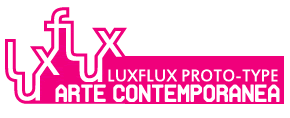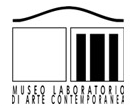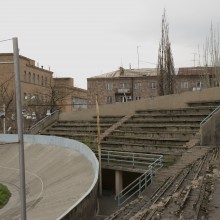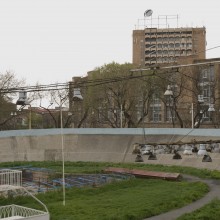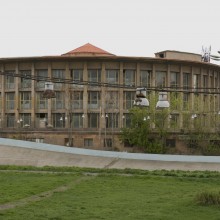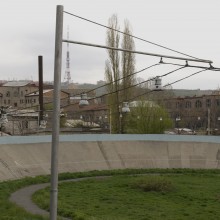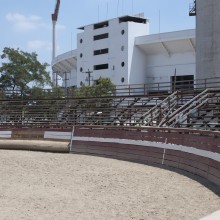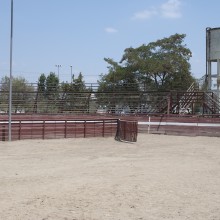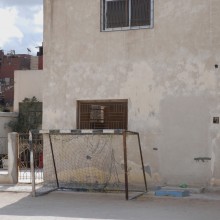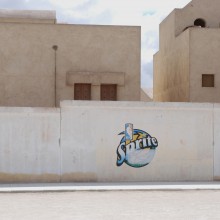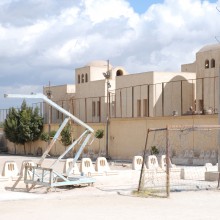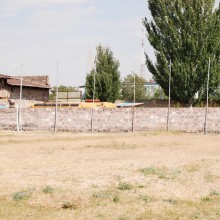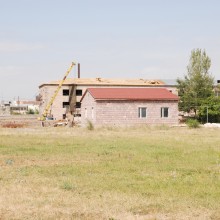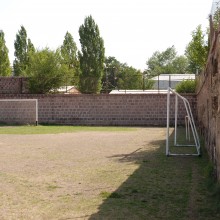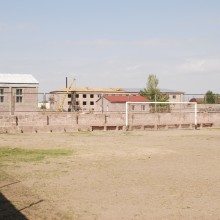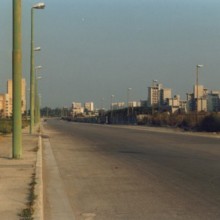Josef Dabernig graduated in sculpture from the Academy of Fine Arts Vienna in 1981. His sculptural discourse successively dissolved into different media such as photography, text and installation. In 1996 he started to make short films, which were presented at festivals such as those in Locarno, Oberhausen, Rotterdam and Toronto. His film “Hypercrisis” was nominated for the European Film Awards at the Venice Film Festival in 2011. Recent exhibitions include: Josef Dabernig: 14 Films; MOCAK Museum of Contemporary Art, Kraków (2013), FORMER WEST: Notes from Berlin; BAK, basis voor actuele kunst, Utrecht (2013), Monday Begins on Saturday; Bergen Assembly, Bergen (2013), Leisure, Discipline and Punishment; 6th Contour Biennial, Mechelen (2013), Josef Dabernig: Panorama; Kunsthaus Graz and Neue Galerie Graz (2013). He participated at the Gwangju Biennale in 2012, the Venice Biennial in 2003 and 2001 and Manifesta 3, Ljubljana in 2000.
Monographs on the artist have been published by Kerber PhotoArt (2013), JRP|Ringier, Zürich (2008) and by Verlag der Buchhandlung Walther König (2005). Dabernig lives and works in Vienna.
The interview was realized in the occasion of the exhibition Josef Dabernig: Textual Photography, curated by Judit Angel, held in the period October 25th –December 1st 2013 in tranzit.sk in Bratislava, Slovak Republic.
tranzit is a network working independently in Austria, the Czech Republic, Hungary, Slovakia and Romania since 2002. It generates deep experience in the local artistic and intellectual biotopes [www.tranzit.org]
Lýdia Pribišová: It seems to me that you are attracted by peripheries, peripheral situations…
Josef Dabernig: I grew up in the periphery itself – on the Carinthian border with Italy, in the east end of the Dolomites.
L.P.: Do you speak Italian?
J.D.: Yes, but I learned it later. On the South Austrian border the atmosphere was due to historical implications more nationalistic. Carinthia is considered to be a quite problematic Austrian province in terms of cultural and political exchange. The Italian language was rarely offered or practiced. I learned it later on my own. But due to a kind of artificial separation, Italy was for me an important place of imagination. Later, when I moved to Vienna, it wasn’t dissimilar with the eastern neighbourhood. The Iron Curtain was there as a disconnection, we had just weak and filtered information. I remember well Austrian television coverage of Bulgaria, which always showed one and the same image. Bulgaria was illustrated by a black-and-white image, shot during rain and darkness….
L.P.: And how was Slovakia represented?
J.D.: I don’t remember well. I guess the image was at that time only one from Prague. In the case of Sofia, the picture showed a Stalinist type of building, the Bulgarian Parliament. The photo in a way represented the country and its connotation was negative. But also the received information about Italy was quite weak in the time my childhood, filtered by prejudices in various directions. So for me also Italy in the 60s was at the same time real and abstract, like the Warsaw Pact Counties were it in the 70s and 80s. Only later, when I filmed in Adamov and Blansko, close to Brno, I was able to verify ‘real socialism’ structures and exploit them in a meanwhile archaeological sense.
L.P.: I think that the most characteristic feature of your work is a concentration of absence. Another characteristic is a very architectonic approach, somewhat like in rationalist architecture, with big volumes and empty spaces. Or like in metaphysical painting. Could you tell more about it?
J.D.: This approach is not so much a construction, but an inherent part of my person. For me society is represented by surrogates of society in the form of architecture. When I came to Bratislava after the Iron Curtain collapsed, I had no contact with the people there. I felt a strong and strange connection to the town, which was not related to an interaction with people. In 1994 I stayed for several months in Krakow in Poland, where I avoided interacting with people for a certain period. I spent the first weeks consciously without closer personal contacts. I wanted to experience the town in terms of the substitutes of architecture, places and situations. It might have something magical, also metaphysical, to experience such an approach via celebrating solitude. Reclusion seems to be one of the central implications in my work.
L.P.: Really, quite all of your photo works are without people. If people are there, they appear on the margins, but they are absent from the centre of your pieces.
J.D.: That’s true. I studied sculpture, but my sculpture was represented by an abstract three-dimensional grid. So I was not really interested in a physical manifestation; my main work was drawing by means of perspective and axonometry, including the process of calculation. In the new urban reality in Krakow I was transcribing by hand the book The History of Naples, written in the Italian language. I bought it in Naples and I copied it in Krakow. The book was superficially not connected to the current reality and it seems that is was a strategy to protect me from excessive demands in a certain situation.
L.P.: So you are looking for some general system of abstraction, some general method that works in different contexts, in various environments and countries?
J.D.: I spent a few months in the Italian seaside village of Torvaianica in 1982, immediately after graduating. I did there 3 hand drawings in four months, nothing more. Two of those drawings subsequently became material for a complex transformation in the direction of abstraction. I applied Pythagoras’ theorem, filtered elements from these drawings and coded and transformed them by means of the theorem. I exploited the source of these drawings over several years. Beginning with end of the 80s my work started to focus on a more minimalistic approach; I preferred using an industrial metal (aluminium) grid system. In the mid- 90s a change in paradigm happened. Prior to that, tabu aspects like private matters and obsessions entered into my work, which opened in the direction of film productions. My piece Hotel Roccalba (2008) features members of my family in a kind of family saga in 10 minutes, where my father, mother, wife, brother, sister-in-law, her mother and my aunt appeared along with me; eight members of my family, extended with 4 friends as ‘adopted’ characters, gathered in a hotel near Tarvisio in Italy.
L.P.: You focus in your work not only on peripheral cities, but also on unimpressive situations and abandoned places in these peripheral cities. Why?
J.D.: I have never in my life been to New York. In times when TV was showing us a negative picture of the East, I always wanted to go to Moscow, but that never happened either. I am a bit of a specialist in Italian culture and history. I took notice of the fact that Naples was one of the most powerful cities in Europe in the 18th and early 19th century. Naples was an incredibly rich town and its decadence only started after the unification of Italy . Then Naples became the city it is today. The previous metropolis declined. When I was later in South America, towns like Buenos Aires, São Paulo or Santiago could not compete with Naples in terms of my sentimental feelings. What happens today in Naples and the hinterland, and also in some other neglected places in Europe, seems to be the downside of European pride and positivism.
L.P.: Back to your photos. The approach in them is very minimalistic, but sometimes there is some particular detail, a quasi-ornament, in contrast to the overall appearance of the whole work. Is there some reason, some intention behind that?
J.D.: What do you mean by “ornament”?
L.P.: In general you employ a regular grid, but often there is some peculiarity, such as a strange staircase or a particular handrail, some “non-grid structure”, such as a spiral…
J.D.: The photos are documents of the places and the places are like they are. I don’t alter these places. For the exhibition in tranzit.sk in Bratislava I made a selection of panoramas, mostly panoramas in six segments, clearly defined, starting from the centre, covering a half circle – 180 degrees. The form of a circle might have something of an ornament, due to its formal redundancy. If you consider a semi-circle to be ornamental, for me it is more geometrical.
L.P.: I meant some particular details (leafing through a catalogue together). One can see a certain type of rhythm.
J.D.: These things happen. They follow the logic of the panorama. Let me refer to two panoramas taken in the Armenian town of Gyumri, which was seriously damaged by an earthquake in 1988. The disaster had around 25,000 victims, and when I was there in 2008 there were still church steeples on the ground documenting the catastrophe. Twenty-five years later the drama is still present in the town. Maybe not in these images, but overall you can feel it fragmentarily. The panorama in 6 parts was shown in “Back to the Individual Experience” in the context of the 9th Gwangju Biennale (curated by Carol Yinghua Lu) in quite large dimensions. Later it was selected by Jacob Fabricius for “Leisure, Discipline and Punishment” within the 6thContour Biennial in Mechelen. Jacob mentioned he had chosen it because of its relationship to a prison. I made clear that the motif is not connected with a prison, but represents the Levon Ishtoyan Football School. At their pitch I was welcomed by a few men. One of them was digging potatoes from the ground. I was quite surprised that in this area of the sports ground – not directly on the pitch, but in the area of the football school, they were digging potatoes. In another corner I saw corn cultivation. They were conducting some kind of parasitic agriculture there. These were details that really fascinated me, but they did not enter my work. The work follows always the regulative: 3 photos to the right, 3 photos to the left, a 180 degree panorama. Normal lens, no zoom and no pan. Of course you could make a documentary showing how they are doing agriculture in a place not dedicated for it. Before leaving the men invited me for coffee and I saw their footballs, which looked as if they were chewed by dogs and not at all nice. The same evening there was a discussion at the Gyumri Biennial and someone from the audience asked, “I would be interesting to learn what this Biennale has to do with everyday things here in the town?” I started do talk about my adventure of that day, having taken a tour to various sports grounds with a taxi driver who was also a football player. At the football school he had introduced me to the managers. I saw these ugly footballs and decided to buy them twenty new ones. But the question that could be posed here is, “Is that art”? For me that really is not art, just an offshoot. My art is one thing and the fact that I was able to organise twenty new footballs is another.
L.P.: Of course. I wanted also to ask you if football interests you also from this social point of view. For example, in Italy Berlusconi has used football as a tool for concentration and manipulation of the masses. Football is a powerful tool in the social context. Is that also your focus?
J.D.: For Berlusconi, as a media tycoon, the investment in football has of course strategic political implications. Berlusconi, Russian oligarchs, Arabian oil sheiks, Asian investors – they all know well that such investments create public identity. In all the bigger stadiums in Cairo I saw the portrait of Hosni Mubarak. Of course they were removed after the Egyptian revolution in 2011. Here (indicating in the catalogue) is the National Stadium of Chile in Santiago, but pictured only in the background of the Rhodeo stadium. I had scruples about including it directly in my collection. The Pinochet regime imprisoned the Salvador Allende sympathizers there in 1973. Detainees were tortured and many of them disappeared to an unknown fate.
L.P.: Had you known this story when you photographed the stadium, or were you fascinated by it independently and later discovered what happened there?
J.D.: When you talk about football in Chile, everybody makes that association. From the beginning, I had the idea of the stadium there as a torture and detention centre. I learned that in the Prater Stadium in Vienna there was a similar round-up of Polish Jews and racial detainees organized by the Nazis, again more than a thousand people. The stadium has a suitable form for concentrating people. You can see everything there from all angles. It’s like a Panopticon in the logic of Foucault.
L.P.: There is still some sense of pathos, but you want to eliminate it. You always avoid showing it.
J.D.: I think so. I try to avoid architecture that is canonical – I deal primarily with anonymous architecture, lack of history. You can hardly resist the power of history. In this sense I prefer the tabula rasa – metaphorically the empty sports ground – to propose something that is very clear in form, very open in meaning.
L.P.: And you also put in your photographs some kind of concealed social criticism?
J.D.: No, the panorama remains just a panorama. I don’t want to connect it to some message; it should remain open towards interpretation.
L.P.: It seems to me, though, that you try somehow to assist in the interpretation, by seeking certain views, certain subjects, which offer many interpretations. Is that right?
J.D.: This might be part of a self-reflexive practice.
L.P.: You are often invited to biennials and shows dealing with this social aspect. Your work is very often contextualized in this way.
J.D.: I avoid making social statements, but subcutaneously they are included. For example, this since demolished rostrum is from the Ferroviario football stadium in Santiago. The ground was a subject of real estate speculation. The rostrum was already burnt. The wood was blackened and my friends from Vaticanochico informed me about the related background.
L.P.: Yes, this has happened also in Slovakia, where they burn down some old building to sell the land for building something else…
J.D.: I am able to give you this information, because I was myself informed about this connection. But for me, in terms of the art piece it remains just a visual manifestation and nothing more. I try to avoid subtext and instruction matters. If you insist, from a more general viewpoint I could claim that these works are some form of media analysis. When you see what the media today offer, it is the opposite to what I propose. I offer nothing and the media are full of promises and speculations.
L.P.: That’s true; even the stadiums are places with a high concentration of spectacle and publicity…
J.D.: I was fascinated in the Coptic part of Cairo, where I found this painted Sprite logo. To find it so prominent in an Arabic country is somehow remarkable. It is an emblem of globalization, although in this case still painted by hands.
L.P.: Now one question concerning your perception of time: You make photographs that work as storyboards and later you became a filmmaker. What is the relationship between your photographs and films?
J.D.: I made my first panorama in 1999 in Naples and it is the outcome of the unclear situation between a private form of travel images and “utilitarian” photography. The photos function from time to time as reminders of film locations, but the body of panorama photographs developed as something independent and consistent, since I have always had this fascination for repetitive things. I have reproduced text by hand-copying it. This was connected with my problematic relationship with language. I hand-copied some books, but the content was only one aspect I was interested in. It was a form of meditation, an anachronistic concept in the digital age, to transcribe a book and ruin my eyesight, because I transcribed them as authentically as possible, with the smallest lettering and as beautifully as possible. I don’t do it anymore. These panoramas succeed the transcriptions. The mapping of places takes the form of photographing them, processing them by computer and again worsening my eyesight.
Dall’alto:
Stadium panorama, 3 – Yerevan Cycle Track. 2011
Stadium panorama, 3 – Yerevan Cycle Track. 2011
Stadium panorama, 3 – Yerevan Cycle Track. 2011
Stadium panorama, 3 – Yerevan Cycle Track. 2011
Stadium panorama, 21 – Santiago – Rodeo Stadium next to National Stadium. 2012
Stadium panorama, 21 – Santiago – Rodeo Stadium next to National Stadium. 2012
Sports ground panorama, 7 – Cairo. 2008
Sports ground panorama, 7 – Cairo. 2008
Sports ground panorama, 7 – Cairo. 2008
Sports ground panorama, 6 – Gyumri – Levon Ishtoyan Football School. 2008
Sports ground panorama, 6 – Gyumri – Levon Ishtoyan Football School. 2008
Sports ground panorama, 5 – Gyumri – Levon Ishtoyan Football School. 2008
Sports ground panorama, 5 – Gyumri – Levon Ishtoyan Football School. 2008
Panorama in Scampia – Naples. 1989
